|
1969 - Gain and loss
As was recorded in 1959 Bickerton’s Aerodromes had been able to purchase a piece of the field which protruded into the South East corner of the aerodrome, this improved the shape of the landing area and the safety of aircraft. The rest of Abrahams field, as it was known, remained a grazing area for cows, so it was important to keep the fences in good order. At this time Air Gregory employed a Sales Manager for the airplanes and helicopters, this was Leslie Singer who was a dynamic man of considerable charm. His presence was not only an asset to Air Gregory but he was helpful to Eva Bickerton who was still managing the aerodrome. It was he who who convinced Mr Abrahams to part with the rest of the field in 1969. With this acquisition the aerodrome became the shape it is today. It immediately made flying safer as there was no longer a fence intruding airside.
|
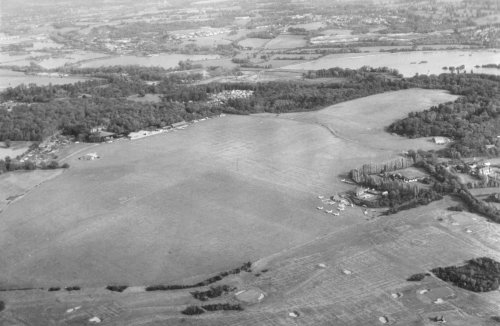
Denham Aerodrome in August of 1969. Due to the difference in mowing, it is possible to make out the shape of the field purchased earlier that year in the right hand corner of the aerodrome, and the L shaped strip around it purchased in 1959.
|
The Air Gregory group seemed to be recovering well from the Tshombe affair, famous names were using their aircraft and the publicity was doing the company no harm. During 1969, Paul McCartney flew to Paris in an Air Gregory HS.125, later in the year John Lennon and Yoko Ono flew in another to Gibraltar to get married, before going on to Paris. The Alouette and Hughes helicopters were busy with a new role, aerial filming for television and films, as well as news broadcasts. During the Torrey Canyon oil tanker disaster in 1967, Ken Gregory claimed to have made Britain's first successful news broadcast from a helicopter and this success had become a growing part of the business in itself. The company also continued their expansion into helicopter charter and training in 1969, primarily with the purchase of two new Hughes 500 five seat helicopters, G-AXEJ and G-AXPL, on 25 April and 31 October respectively. The Hughes 500, also known as the 369H, began life in response to a US Army requirement for a new light utility helicopter. Known as the Hughes OH-6 Cayuse, it first flew in February 1963, but even before this Hughes announced the development of a civilian model, the 500. Nearly 5,000 of these fast and powerful turbine powered aircraft have been built in many different models, a success story that continues in production today.
The Hughes 500 allowed Air Gregory greater flexibility in its charter operations, but since the small rotor diameter and short fuselage gave the type an ease of handling lacking in many early helicopters, it also quickly became popular as a trainer for the group. The latter aircraft, G-AXPL, was sold to The Honourable Michael Pearson, 4th Viscount Cowdray, in December 1970 and repainted in a black and silver scheme. Co-incidentally, both aircraft were to feature in the TV series "The Persuaders" during 1971 and 1972. G-AXPL appeared in episode 11, Chain of Events, and G-AXEJ in episode 17, Five Miles to Midnight, wearing Air Gregory colours but with the G prefix of its registration blacked out as the episode was supposed to be based in Switzerland!
|
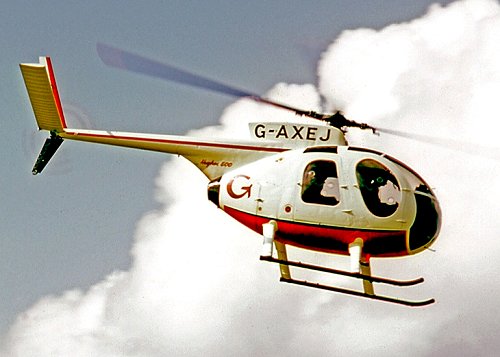
The first Hughes 500 in the Air Gregory fleet was G-AXEJ, purchased on 25 April.
|
|
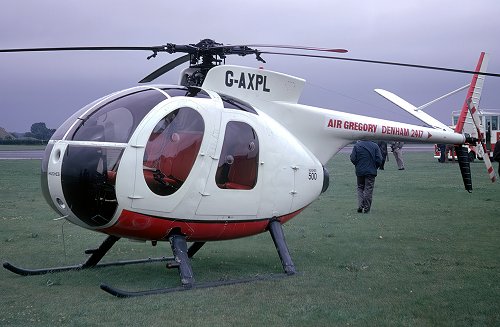
Hughes 500 G-AXPL joined the Air Gregory fleet in October, and carried the company phone number on the tail boom.
|
|
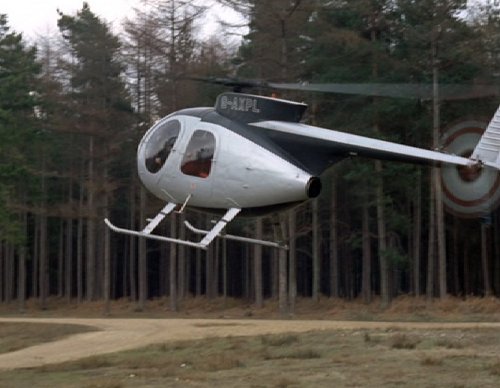
Repainted into this black and silver scheme for the 4th Viscount Cowdray, G-AXPL is seen here in episode 11 of The Persuaders.
|
|
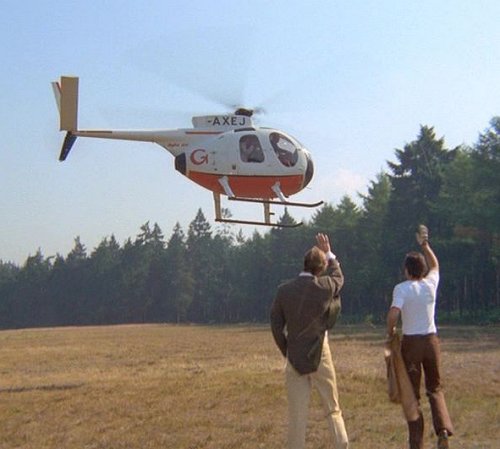
Roger Moore and Tony Curtis wave farewell to G-AXEJ in episode 17 of The Persuaders, note the white panel over the G of the registration.
|
Despite these expansions and the continued success of the Air Gregory group, there was a difference of opinion regarding the direction of the group between the new owner, David Wickens of Bristol Street Motors, and Ken Gregory, who had been retained as a board member and forty percent shareholder due to his extensive experience and market knowledge. Between January and September, all three Hawker Siddeley HS.125 business jets and all three de Havilland dH.106 Doves were sold, reducing the air taxi side of the business to the much smaller Piper Aztec and Twin Comanche fleet, which limited its capabilities accordingly. For Ken Gregory this was a step too far, and he resigned from the board of directors. It is not to much to suggest that had his idea for a cheap charter holiday airline succeeded he would have pre-dated Laker airlines by ten years and the likes of EasyJet and Ryan Air by nearly thirty, so one wonders what shape the world of civil aviation would be now had that been the case. Sadly, it was not too be, Ken Gregory's ambition outstripped the market's readiness and the technology available, but it must be said his failure was not caused by a lack of either imagination nor effort. He was to begin several new successful careers from real estate development to exhibition management, but is best remebered for his motoring publishing, founding amongst others Cars and Car Conversions magazine, a field he knew well from his time as a motor racing manager. Interestingly, he had first been to Silverstone not to a motor race, but during the Second World War while he was serving with the Glider Pilot Regiment as a Horsa pilot at nearby Finmere airfield. He eventually retired to Spain, and died, aged 87, on 1 December 2013.
|
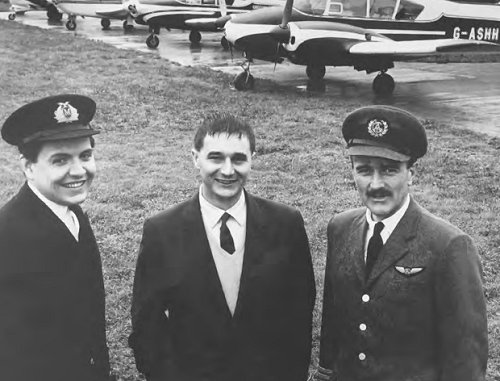
Ken Gregory, centre, in happier times at Denham in the early 1960s with two of his pilots and a number of his aircraft.
|
While all this was going on in the background at Denham during 1969, one event brought the aerodrome to the fore. The Guild of Air Pilots and Navigators (GAPAN) had enjoyed great success with their air display in 1967, so returned to Denham on 21 June to repeat the exercise, again with the proceeds going to the GAPAN Benevolent Fund and the Air Safety Trust. All the aerodrome residents became involved in assisting with the show, and one famous neighbour, Air Vice Marshal Don Bennett, lent his adjoining field to act as an overflow car park. The programme was a varied as the previous event with a wide variety of historic and modern aircraft and several displays by the enthusiastic members of the Tiger Club. Once more, the RAF provided a Jet Provost team, this time the Linton Gin from RAF Linton on Ouse who made something of a stir when they landed and then operated from the grass at Denham. The programme is reproduced in full below, as are a number of images from what was an exciting and varied event.
|

The programme for the 1969 GAPAN Air Display.
|
|

The programme for the 1969 GAPAN Air Display.
|
|
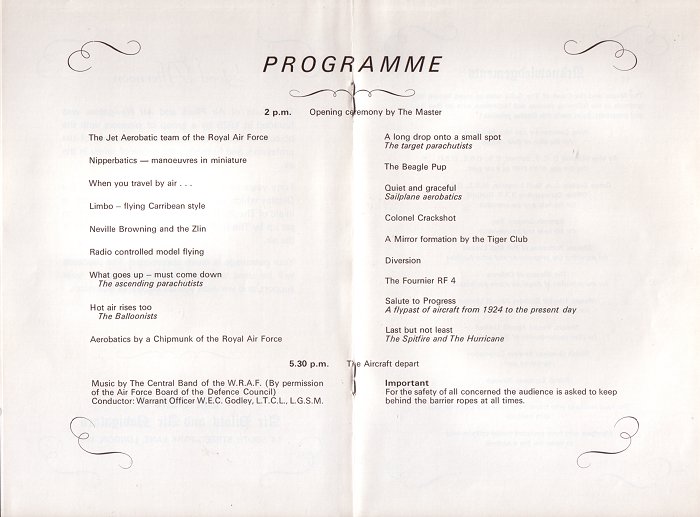
The programme for the 1969 GAPAN Air Display.
|
|

The programme for the 1969 GAPAN Air Display.
|
|

The RAF Jet Provost display team, the Linton Gin, operated from the grass at Denham for the display.
|
|
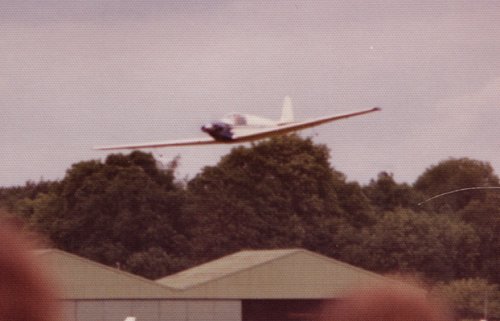
The Fournier RF-4 motor glider gave a smooth and quiet display of aerobatics.
|
|
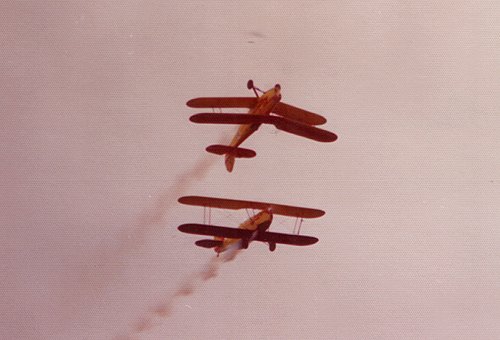
The Tiger Club provided several items for the programme, including their pair of Stampe SV.4Cs in a mirror formation display.
|
|
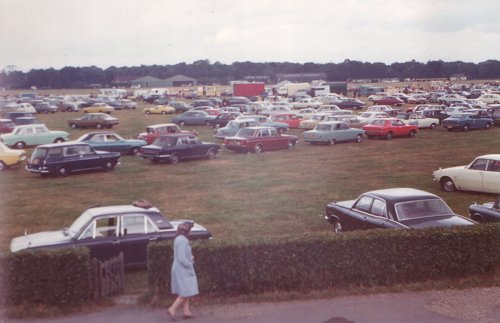
The second GAPAN display was as big a success as the first, the main car park quickly filled, so the overflow field kindly provided by Air Vice Marshal Bennett was soon needed.
|
A great loss was to strike the aerodrome on 25 November 1969. Eva Bickerton, who had managed the aerodrome for the previous 16 years and had turned it into a business from her husband’s hobby, died of cancer. Her wise decisions had put the business on a sound footing. She was much missed by all who knew her. Fortunately her sister, Lucy Griffiths, had stepped in to carry on the financial side of the business and her daughter, Beatrice, who had given up a career in aviation to marry and raise a family, took over the management of the aerodrome itself.
Another cloud had already darkened the atmosphere at Denham the previous month as Lord Douglas of Kirtleside, close neighbour and friend to the aerodrome, had also died. This was to have a great impact in the future.
While the year ended on a sombre note, a new decade beckoned and the new aerodrome manager was to take Denham into the 1970's, as will be related next.
|
|

